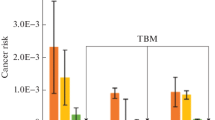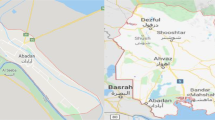Abstract
The cancer risks (CR) by oral ingestion, dermal absorption, and inhalation exposure of trihalomethanes (THM) from tap water of ten districts in Fortaleza, Brazil were estimated. The mean levels of THM compounds were obtained in Fortaleza tap water as follow: 63.9 μg L−1 for chloroform (CHCl3), 40.0 μg L−1 for bromodichloromethane (CHBrCl2), and 15.6 μg L−1 for dibromochloromethane (CHBr2Cl). Bromoform (CHBr3) was not detected. The mean CR for THMs in tap water is 3.96 × 10−4. The results indicate that Fortaleza residents have a higher CR by inhalation than dermal absorption and oral ingestion. The CR for CHCl3 contributes with 68% as compared with the total CR, followed by CHBrCl2 (21%), and CHBr2Cl (11%). The hazard index (HI) is about ten times lower than unity, not indicating non-cancer effects.
Similar content being viewed by others
References
Aggazzotti, G., Fantuzzi, G., Tartoni, P. L., & Predieri, G. (1990). Plasma chloroform concentrations in swimmers using indoor swimming pools. Archives of Environmental Health, 45, 175–179.
Ali, M. Y. A., & Ripley, J. P. (1990). Distribution of halomethanes in potable waters of Kuwait. Water Research, 24, 533–538.
Attias, L., Contu, A., Loizzo, A., Massiglia, M., Valente, P., & Zapponi, G. A. (1995). Trihalomethanes in drinking water and cancer—Risk assessment and integrated evaluation of available data in animals and humans. Science of the Total Environment, 171, 61–68.
Backer, L. C., Ashley, D. L., Bonin, M. A., Cardinali, F. L., Kieszak, S. M., & Wooten, J. V. (2000). Household exposures to drinking water disinfection by-products: Whole blood trihalomethane levels. Journal of Exposure Analysis and Environmental Epidemiology, 10, 321–326.
Batterman, S., Huang, A. T., Wang, S. G., & Zhang, L. (2000). Reduction of ingestion exposure to trihalomethanes due to volatilization. Environmental Science Technology, 34, 4418–4424.
Boorman, G. A., Dellarco, V., Dunnick, J. K., Chapin, R. E., Hunter, S., Hauchman, F., et al. (1999). Drinking water disinfection byproducts: Review and approach to toxicity evaluation. Environmental Health Perspective, 107, 207–217.
Budziak, D., & Carasek, E. (2007). Determination of trihalomethanes in drinking water from three different water sources in Florianopolis-Brazil using purge and trap and gas chromatography. Journal of Brazilian Chemical Society, 18, 741–747.
Cherrie, J. W., & Robertson, A. (1995). Biologically relevant assessment of dermal exposure. Annals of Occupational Hygiene, 39, 387–392.
Chow, A. T., Gao, S., & Dahlgren, R. A. (2005). Physical and chemical fractionation of dissolved organic matter and trihalomethane precursors: A review. Journal of Water Supply Research Technology-Aqua, 54, 475–507.
Egorov, A. I., Tereschenko, A. A., Altshul, L. M., Vurtiainen, T., Samsonov, D., LaBrecque, B., et al. (2003). Exposures to drinking water chlorination by products in a Russian city. International Journal of Hygiene and Environmental Health, 206, 539–551.
Erdinger, L., Kuhn, K. P., Kirsch, F., Feldhues, R., Frobel, T., Nohyenek, B., et al. (2004). Pathways of trihalomethane uptake in swimming pools. International Journal of Hygiene and Environmental Health, 207, 571–575.
Fantuzzi, G., Righi, E., Predieri, G., Ceppelli, G., Gobba, F., & Aggazzotti, G. (2001). Occupational exposure to trihalomethanes in indoor swimming pools. Science of the Total Environment, 264, 257–265.
Gordon, S. M., Wallace, L. A., Callahan, P. J., Kenny, D. V., & Brinkman, M. C. (1998). Effect of water temperature on dermal exposure to chloroform. Environmental Health Perspective, 106, 337–345.
Graves, C. G., Matanoski, G. M., & Tardiff, R. G. (2001). Weight of evidence for an association between adverse reproductive and developmental effects and exposure to disinfection by-products: a critical review. Regulatory Toxicology Pharmacology, 34, 103–124.
Hsu, C. H., Jeng, W. L., Chang, R. M., Chien, L. C., & Han, B. C. (2001). Estimation of potential lifetime cancer risks for trihalomethanes from consuming chlorinated drinking water in Taiwan. Environmental Research, 85, 77–82.
IARC (1991). Chlorinated drinking-water; chlorination by-products; some other halogenated compounds; cobalt and cobalt compounds. IARC Monographs for the Evaluation of the Carcinogenic Risk of Chemicals to Humans, Vol. 52. Lyon: International Agency for Research on Cancer.
IARC (1999). Chloroform. Group 2B. IARC Monographs for the Evaluation of the Carcinogenic Risk of Chemicals to Humans, Vol. 73. Lyon: International Agency for Research on Cancer.
Jo, W. K., Kwon, K. D., Dong, J. I., & Chung, Y. (2005). Multi-route trihalomethane exposure in households using municipal tap water treated with chlorine or ozone-chlorine. Science of the Total Environment, 339, 143–152.
Jo, W. K., Weisel, C. P., & Lioy, P. J. (1990). Chloroform exposure and the health risk associated with multiple uses of chlorinated tap water. Risk Analysis, 10, 581–585.
Komulainen, H. (2004). Experimental cancer studies of chlorinated by-products. Toxicology, 198, 239–248.
Kuo, H. W., Chiang, T. F., Lo, I. I., Lai, J. S., Chan, C. C., & Wang, J. D. (1998). Estimates of cancer risk from chloroform exposure during showering in Taiwan. Science of the Total Environment, 218, 1–7.
LeBel, G. L., Benoit, F. M., & Williams, D. T. (1997). A one-year survey of halogenated disinfection by-products in the distribution system of treatment plants using three different disinfection processes. Chemosphere, 34, 2301–2317.
Lee, S. C., Guo, H., Lam, S. M. J., & Lau, S. L. A. (2004). Multipathway risk assessment on disinfection by-products of drinking water in Hong Kong. Environmental Research, 94, 47–56.
Levesque, B., Ayotte, P., Leblanc, A., Dewailly, E., Prudhomme, D., Lavoie, R., et al. (1994). Evaluation of dermal and respiratory chloroform exposure in humans. Environmental Health Perspective, 102, 1082–1087.
Lin, T. F., & Hoang, S. W. (2000). Inhalation exposure to THMs from drinking water in south Taiwan. Science of the Total Environment, 246, 41–49.
Little, J. C. (1992). Applying the two-resistance theory to contaminant volatilization in showers. Environmental Science Technology, 26, 1341–1349.
Miles, A. M., Singer, P. C., Ashley, D. L., Lynberg, M. C., Mendola, P., Langlois, P. H., et al. (2002). Comparison of trihalomethanes in tap water and blood. Environmental Science Technology, 36, 1692–1698.
Ministério da Saúde (2004) Diário Oficial da União. Brasília, DF: MS; Portaria No 518/2004.
Moudgal, C. J., Lipscomb, J. C., & Bruce, R. M. (2000). Potential health effects of drinking water disinfection by-products using quantitative structure toxicity relationship. Toxicology, 147, 109–131.
Nieuwenhuijsen, M. J., Toledano, M. B., Eaton, N. E., Fawell, J., & Elliott, P. (2000). Chlorination disinfection byproducts in water and their association with adverse reproductive outcomes: a review. Occupational Environmental Medicine, 57, 73–85.
Nuckols, J. R., Ashley, D. L., Lyu, C., Gordon, S. M., Hinckley, A. F., & Singer, P. (2005). Influence of tap water quality and household water use activities on indoor air and internal dose levels of trihalomethanes. Environmental Health Perspective, 113, 863–870.
Sadiq, R., Husain, T., & Kar, S. (2002). Chloroform associated health risk assessment using bootstrapping: A case study for limited drinking water samples. Water Air and Soil Pollution, 138, 123–140.
Staudinger, J., & Roberts, P. V. (2001). A critical compilation of Henry’s law constant temperature dependence relations for organic compounds in dilute aqueous solutions. Chemosphere, 44, 561–576.
Tokmak, B., Capar, G., Dilek, F. B., & Yetis, U. (2004). Trihalomethanes and associated potential cancer risks in the water supply in Ankara, Turkey. Environmental Research, 96, 345–352.
US EPA (1990). Exposure factors handbook. Office of health and environmental assessment. Washington, DC: EPA 600y8-89y043.
US EPA (1999). Guidelines for carcinogen risk assessment. Risk assessment forum. U.S. Government Printing Office. Washington, DC: EPA NCEA-F-0644.
US EPA (2006). Integrated risk information system (Electronic data base). U.S. Environmental Protection Agency; (January). http://www.epa.gov/iris.
Uyak, V. (2006). Multi-pathway risk assessment of trihalomethanes exposure in Istanbul drinking water supplies. Environment International, 32, 12–21.
Valente, A. L. P., Augusto, F., Montero, L., da Rocha, E. C., & Pawliszyn, J. (1998). Application of SPME (solid phase micro-extraction) to the analysis of drinkable water from three locations in the state of São Paulo. Quimica Nova, 21, 804–806.
Weisel, C. P., & Jo, W. K. (1996). Ingestion, inhalation, and dermal exposures to chloroform and trichloroethene from tap water. Environmental Health Perspective, 104, 48–51.
Williams, P., Benton, L., Warmerdam, J., & Sheeham, P. (2002). Comparative risk analysis of six volatile organic compounds in California drinking water. Environmental Science Technology, 36, 4721–4728.
Xu, X., Mariano, T. M., Laskin, J. D., & Weisel, C. P. (2002). Percutaneous absorption of trihalomethanes, haloacetic acids, and haloketones. Toxicology and Applied Pharmacology, 184, 19–26.
Author information
Authors and Affiliations
Corresponding author
Rights and permissions
About this article
Cite this article
Viana, R.B., Cavalcante, R.M., Braga, F.M.G. et al. Risk assessment of trihalomethanes from tap water in Fortaleza, Brazil. Environ Monit Assess 151, 317–325 (2009). https://doi.org/10.1007/s10661-008-0273-y
Received:
Accepted:
Published:
Issue Date:
DOI: https://doi.org/10.1007/s10661-008-0273-y




